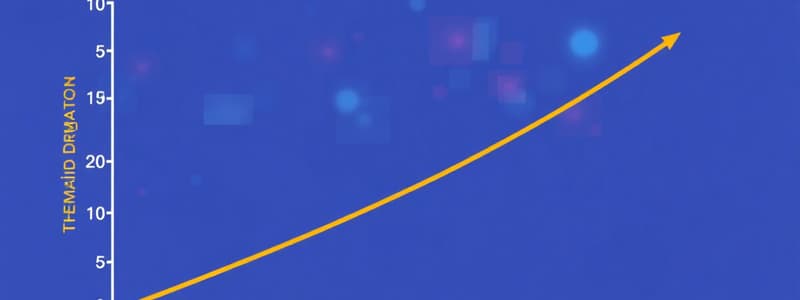Podcast
Questions and Answers
What characterizes a competitive market?
What characterizes a competitive market?
- There are many buyers but only one seller.
- No buyer or seller can influence the market price. (correct)
- Prices are set by a single seller.
- A few sellers dominate the market.
What does the law of demand state?
What does the law of demand state?
- The quantity demanded decreases when prices increase. (correct)
- As income increases, demand always decreases.
- Demand is unrelated to prices.
- The quantity demanded increases when prices rise.
Which of the following factors can shift the demand curve?
Which of the following factors can shift the demand curve?
- A movement along the supply curve.
- Technological advancements in production.
- Changes in consumer income. (correct)
- Substitutes becoming available. (correct)
What is indicated by a movement along the demand curve?
What is indicated by a movement along the demand curve?
What is supply typically represented by?
What is supply typically represented by?
Which of the following statements accurately describes quantity supplied?
Which of the following statements accurately describes quantity supplied?
How is market demand determined?
How is market demand determined?
Which statement is true regarding the law of supply?
Which statement is true regarding the law of supply?
What occurs when quantity supplied exceeds quantity demanded?
What occurs when quantity supplied exceeds quantity demanded?
What is the equilibrium price?
What is the equilibrium price?
What does the price elasticity of demand measure?
What does the price elasticity of demand measure?
What happens to total revenue when demand is inelastic and price increases?
What happens to total revenue when demand is inelastic and price increases?
In the scenario where income elasticity of demand is less than 0, the good is categorized as what type?
In the scenario where income elasticity of demand is less than 0, the good is categorized as what type?
Which of the following statements about demand curves is true?
Which of the following statements about demand curves is true?
Using the midpoint method, how is the price elasticity of demand calculated?
Using the midpoint method, how is the price elasticity of demand calculated?
When demand is perfectly inelastic, what happens to the quantity demanded as price changes?
When demand is perfectly inelastic, what happens to the quantity demanded as price changes?
Flashcards are hidden until you start studying
Study Notes
Markets
- A market is a group of buyers and sellers of a particular good or service.
- Markets can be highly organized, like agricultural commodities, or less organized, like a small ice cream shop.
- A competitive market has so many buyers and sellers that no individual buyer or seller can influence the market price.
- In a perfectly competitive market, buyers and sellers are price takers, meaning they must accept the prevailing market price.
- A monopoly is a market with only one seller who sets the price.
Demand
- The demand curve shows the relationship between the price of a good and the quantity demanded.
- Quantity demanded is the amount of a good that buyers are willing and able to purchase at a given price.
- The Law of Demand states that, other things being equal, the quantity demanded of a good falls when the price of the good rises.
- Market Demand is the sum of the demand from all individuals in the market.
- Factors that can affect market demand include income, prices of related goods, tastes, expectations, and the number of buyers.
- Movement along the demand curve represents a change in quantity demanded due to a change in price.
- Shift of the demand curve represents a change in demand due to factors other than price, such as income or consumer preferences.
Supply
- The supply curve shows the relationship between the price of a good and the quantity supplied.
- Quantity supplied is the amount of a good that sellers are willing and able to sell at a given price.
- The Law of Supply states that, other things being equal, the quantity supplied of a good rises when the price of the good rises.
- Market Supply is the sum of the supplies of all sellers.
- Factors that can shift the supply curve include input prices, technology, expectations, the number of sellers, and government policies.
Equilibrium
- Equilibrium is a state where the quantity supplied and quantity demanded are equal at a specific price.
- Equilibrium price is the price that balances quantity supplied and quantity demanded.
- Equilibrium quantity is the quantity supplied and demanded at the equilibrium price.
- Surplus occurs when the quantity supplied exceeds the quantity demanded.
- Shortage occurs when the quantity demanded exceeds the quantity supplied.
Elasticity
- Elasticity is a measure of the responsiveness of quantity demanded or quantity supplied to one of its determinants.
- Price elasticity of demand measures the responsiveness of quantity demanded to a change in price.
- Income elasticity of demand measures the responsiveness of quantity demanded to a change in income.
- Cross-price elasticity of demand measures the responsiveness of quantity demanded of one good to a change in the price of another good.
Total Revenue
- Total Revenue is the amount paid by buyers and received by sellers of a good, calculated as price times quantity (TR = P x Q).
- When demand is inelastic, price and total revenue move in the same direction.
- When demand is elastic, price and total revenue move in opposite directions.
- When demand is unit elastic, total revenue remains constant when price changes.
Other Demand Elasticities
- An inferior good has negative income elasticity of demand, meaning demand decreases as income rises (e.g., margarine).
- A normal good has positive income elasticity of demand, meaning demand increases as income rises (e.g., luxury goods).
Studying That Suits You
Use AI to generate personalized quizzes and flashcards to suit your learning preferences.




